Do you think the plain ol’ white button mushroom is boring?
Do you breeze by it in the grocery store, opting instead for the sexier wild mushrooms? Do you associate it with those tasteless, soggy lumps from cheap takeout?
Well, think again! This ordinary species, Agaricus bisporus, is one of the most commonly grown mushrooms throughout the world. It’s eaten by millions of people every day. And with a little culinary flair, it’s anything but boring.
There are some great reasons not to pass by this mushroom in the grocery store. They’re relatively inexpensive, easy to find, have a great taste, and they’re harder to mangle in a recipe than the delicate chanterelle or delicious morel.
There’s more to this species than meets the eye! In this article I’ll cover cooking and eating them, where to get and how to grow them, and some fun button facts. Also, do you know the difference between the button mushroom, cremini mushroom, and portobello? Find out here!
Jump to:
How to Cook Button Mushrooms
One of the reasons I love the white button is that they’re so easy to cook. They hold their flavor well, and are much more forgiving in a recipe than certain wild mushrooms. Go ahead and put the heat to them!
Choose – If picking mushrooms from the grocery store, look for young specimens with unopened caps and no signs of bruising or sliminess.
Clean – Too much time in water runs the risk of making the mushroom mushy, so clean them with just a quick rinse or a damp cloth. Make sure they’re dry before cooking so they crisp up better.
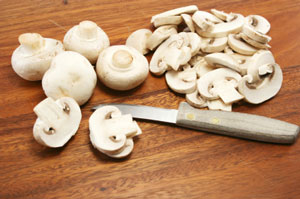 Storage – Agaricus bisporus will last longer in your refrigerator than many other mushrooms, usually around a week. It’s better to store them in a paper bag rather than plastic. They’ll last even longer if you take the time to put them in paper!
Storage – Agaricus bisporus will last longer in your refrigerator than many other mushrooms, usually around a week. It’s better to store them in a paper bag rather than plastic. They’ll last even longer if you take the time to put them in paper!
Cook – You can use these in almost any recipe. Go ahead and prepare them in soups, stews, and stir frys. Use them as a flavorful topping for meat, fish, poultry, or pizza. Marinate them. Skewer and grill them. Chop them up and use them in a mushroom duxelles recipe. Your imagination is the limit!
Yet the easiest way to cook them is in a simple sauté. By chopping them up and sautéing with a little oil that has a high smoke point, you’re left with delicious little flavor bombs that you could add to any recipe.
Simple and fun instructions on how to make an easy mushroom sauté!
Are Button Mushrooms Good for You, and Should You Eat Them Raw?
The simple answers to these questions are yes…and no.
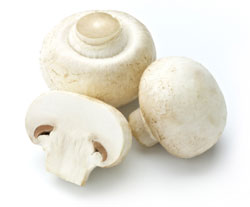
There’s been a lot of talk in the past few years about mushrooms and vitamin D. While button mushrooms on their own don’t contain a lot of vitamin D, Monterey Mushrooms discovered that if you expose them to pulses of UV light while growing, it drastically increases their vitamin D content.
Since so many people are D deficient, this is a nice breakthrough for those needing a daily dose of this important vitamin.
See how Monterey Mushrooms increases the vitamin D content in the Agaricus bisporus in the fun little video below.
So button mushrooms are definitely good for you, but can they be bad for you as well?
Agaricus bisporus, along with many other edible mushrooms, contain a few poisonous or irritating compounds. These include hydrazines, a group of carcinogenic chemicals.
These chemicals occur in small amounts, and who hasn’t eaten a salad with some raw mushrooms on it before? Eating a raw button mushroom isn’t going to kill you, but who knows what a small amount of chemical exposure can do to you over time.
Fortunately these compounds are greatly reduced by cooking. For this reason, and the fact that the uncooked, chitinous cell walls of a mushroom are hard for a human to digest, I always recommend eating mushrooms cooked.
Oh sure, there are many people out there who love their raw mushrooms. Yet they really should be cooked before eating. Not only do you reduce or eliminate toxic compounds, but also the heat breaks down the mushroom cell walls and allows your body to absorb more of the healthy nutrients that fungi have to offer.
For a longer treatise on eating raw mushrooms, I’d recommend this article by David Campbell on MykoWeb.
So go ahead and enjoy your mushrooms on salads or anything else. Just cook them first. Research shows that it’s better for you, and they taste better too!
What’s The Difference Between White Buttons, Cremini, and Portobellos?
Do you know the difference between these three popular edible mushrooms? They’re actually all the same species: Agaricus bisporus!
A cremini mushroom is just a brown strain of the white button. A portobello is a cremini that’s been allowed to grow to maturity. So they’re more closely related than one may think.
Below is a handy chart that sums it up:
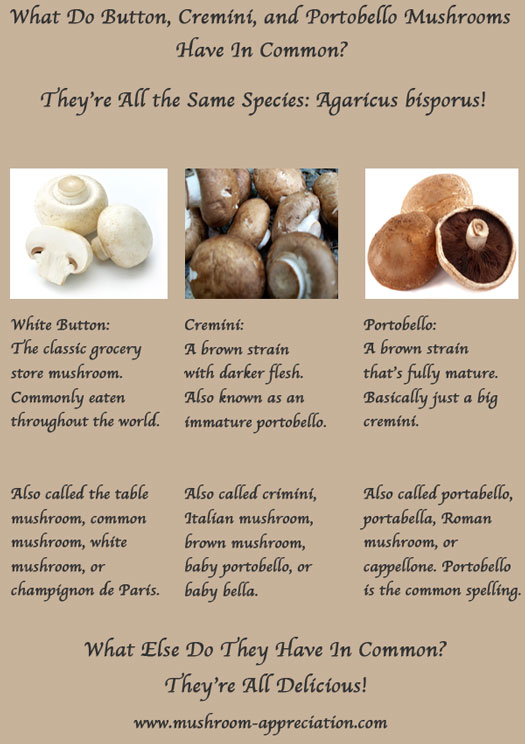
Where to Get Your Button Mushrooms
The easiest way to acquire them for dinner is to make a trip to your local grocery or natural foods store.
I know this may sound far more frightening than going mushroom hunting. You’ll have to put on real pants. You could run into that old flame you’re trying to avoid. Or you could just run the risk of spending way more money at the grocery store than you had intended.
For most people, simply purchasing these mushrooms is much easier and safer than trying to find them outdoors. Yes, there are native and non-native strains of button mushrooms growing in the wild.
Yet due to their simple physical appearance it’s very easy to confuse them for something else. There are a lot of white mushrooms out there, including the deadly death cap mushroom.
A mistake could range from sickening to outright fatal, so beginners are discouraged from hunting this species. It’s considered a more advanced mushroom. So if you’re really set on collecting it, have someone teach you hands-on in your area!
Now what about cultivating these mushrooms on your own? It’s way more fun than the grocery store, but much more complicated because composting is involved.
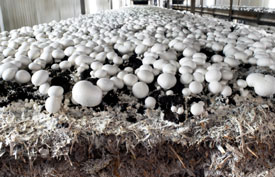
Members of the Agaricus genus are all secondary decomposers, meaning other fungi or bacteria have to break down the wood into compost before they can grow. This leads to a much more complicated process of cultivation.
For a great introduction of how this process is done, check out the button mushroom article at Tom Volk’s site. It gives a fun overview of growing via composting.
If you’re still hot to grow your own on a major scale, I’d recommend Paul Stamets’ book Growing Gourmet and Medicinal Mushrooms. A more comprehensive book on mushroom growing you will not find!
Of course, for the casual non-commercial grower you can buy white button mushroom kits. These will let you cultivate your own crop without all the hassle.
Using a kit to grow mushrooms is easy, fun, educational, and delicious!
Fun Facts About the Simple Button Mushroom
- Agaricus bisporus goes by many names: the button mushroom, white mushroom, table mushroom and my favorite in French, champignon de Paris (Paris mushroom). The brown strain is called crimini, cremini, baby bella, or Italian mushroom. When the brown strain grows larger and reaches maturity it’s called the portobello. Yes, these are all the same species! (See chart above).
- Of course the Latin name has a special meaning too. Agaricus means “gilled mushroom”. Bisporus means that the basidia, the spore-producing structures on the gills, contain two spores instead of the usual four. The picture below is a nice example of normal, four-spored basidia. (By Debivort on Wikipedia. Published under the GNU Free Documentation license.)
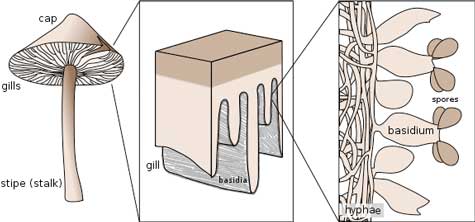
- The button mushroom is a saprotroph, meaning it feeds on dead or dying organic matter. You’ll find them in grasslands and fields all over the world.
- These babies are known to pop up after a rain anytime from spring to fall.
- While not a famous medicinal mushroom, there is evidence that the simple button can boost the immune system and fight cancer. A 2009 study found that compounds from this mushroom might inhibit cancer cell growth, although they admit further research is needed. See the interesting excerpt from the study here.
- The flesh is white, but will turn a pinkish color upon bruising. Eventually the pink will turn brown. You’ll see this if you put a lot of pressure on your mushrooms while handling them.
- The spore print is a dark brown.
- The table mushroom is very popular in the United States. It’s estimated that the average consumption per person is around 2 lbs per year.
I hope this article has given you a new appreciation for the button mushroom. Don’t forget about them the next time you need a hearty addition to an inexpensive meal!

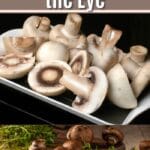
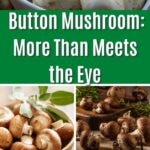

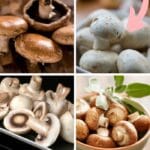
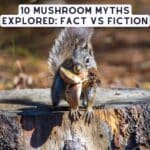
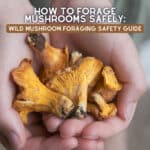
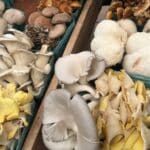
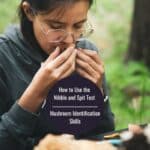
Leave a Reply